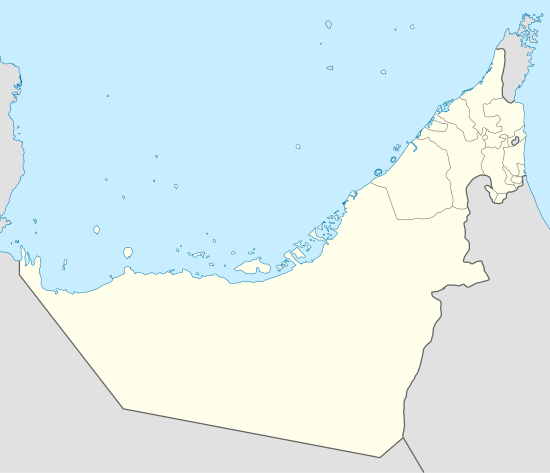Umm al-Nar culture
| Umm al-Nar | |
|---|---|
 Umm al-Nar | |
| Coordinates: 24°26′18″N 54°30′52″E / 24.43833°N 54.51444°E | |
| Country |
|
| Elevation | 5 m (16 ft) |
Umm al-Nar (Arabic: ام النار "Mother of fire") (also known as Umm an-Nar) is the name given to a bronze age culture that existed around 2600-2000 BC in the area of modern-day United Arab Emirates and Northern Oman. The etymology derives from the island of the same name which lies adjacent to Abu Dhabi.[1][2]
Location
The key site is well protected, but its location between a refinery and a sensitive military area means public access is currently restricted. The UAE authorities are working to improve public access to the site, and plan to make this an Abu Dhabi cultural location.
Attributes
One element of the Umm al-Nar culture is circular tombs typically characterized by well fitted stones in the outer wall and multiple human remains within.[3]
The Umm an-Nar culture covers around five or six centuries (2600-2000 BC). The name is derived from Umm al-Nar, a small island located on the southeast of the much larger island Abu Dhabi. It is one of 200 islands that dominate the coast of Abu Dhabi.
Excavations
The first archaeological excavations in Abu Dhabi began at Umm al-Nar in 1959, twelve years before the foundation of the United Arab Emirates. Seven tombs from a total of fifty and three areas at the ruins of the ancient settlement were examined by the Danish Archaeological Expedition. During their first visit they identified a few exposed shaped stones fitted together at some of the stone mounds. The following year (February 1959) the first excavations started at one of the mounds on the plateau, now called Tomb I. Two more seasons (1960 and 1961) involved digging more tombs, while the last three seasons (1962/1963, 1964 and 1965) were allocated to examining the settlement.
The Danish excavations on Umm al-Nar halted in 1965 but were resumed in 1975 by an archaeological team from Iraq. During the Iraqi excavations which lasted one season, five tombs were excavated and a small section of the village was examined. Between 1970 and 1972 an Iraqi restoration team headed by Shah Al Siwani, former member of the Antiquities Director in Baghdad, restored and/or reconstructed the Danish excavated tombs.
At Al Sufouh Archaeological Site in Dubai, archaeological excavation between 1994 and 1995 revealed an Umm Al-Nar type circular tomb dating between 2500 and 2000 B.C.
Dilmun Burial Mounds in Bahrain also feature Umm al-Nar Culture remains.
At Tell Abraq, UAE, settlements associated with the start of the Umm al-Nar Culture began c. 2500 BC.
Occupation phases
The Ubaid period (5000-3800 BC) is the oldest period known in Ras Al Khaimah, UAE. Pottery vessels of the period already show contact with Mesopotamia.[4]
The Hafit period followed the Ubaid period. During the Hafit period (3200 - 2600 BC) burial cairns with the appearance of a beehive appeared, consisting of a small chamber for one to two burials.
The distinctive circular tombs of the Umm al-Nar period (2600-2000) distinguish it from the preceding Hafit period, together with finds of distinctive black on red decorated pottery and jewellery made with gems such as carnelian, sourced from the Indus Valley.
After Umm al-Nar, the Wadi Suq culture followed (2000-1300 BC), a period which saw more inland settlement, increasingly sophisticated metallurgy and the domestication of the camel.
The poorly represented last phase of the Bronze Age (1600-1300 BC) has only been vaguely identified in a small number of settlements. This last phase of the Bronze Age was followed by a boom when the underground irrigation system (the qanat here called falaj) was introduced during the Iron Age (1300-300 BC) by local communities.[5]
See also
References
- ↑ UAE History: 20,000 - 2,000 years ago - UAEinteract Archived 2013-06-13 at the Wayback Machine.
- ↑ "UNESCO - Tentative Lists". Settlement and Cementery of Umm an-Nar Island. UNESCO. Retrieved 18 December 2017.
- ↑ Introduction to the Archaeology of Ras Al Khaimah rakheritage.rak.ae
- ↑ Introduction to the Archaeology of Ras Al Khaimah rakheritage.rak.ae
- ↑ The Island of Umm-an-Nar Volume 1: Third Millennium Graves (Jutland Archaeological Society Publications) (v. 1) [Hardcover] Karen Frifelt (Author), Ella Hoch (Contributor), Manfred Kunter (Contributor), David S. Reese (Contributor)]; Island of Umm-an-Nar Volume 2: The Third Millennium Settlement (Jutland Archaeological Society Publications)December 1, 1995 ]
Coordinates: 24°26′21″N 54°30′16″E / 24.43917°N 54.50444°E
Bibliography
- P. Yule–G. Weisgerber, The Tower Tombs at Shir, Eastern Ḥajar, Sultanate of Oman, in: Beiträge zur allgemeinen und vergleichenden Archäologie (BAVA) 18, 1998, 183–241, ISBN 3-8053-2518-5.
- Karen Frifelt, The Island of Umm-an-Nar. Jutland Archaeologcia Society Publications, Aarhus 1995
- Walid Yasin Al Tikriti: Archaeology of Umm an-Nar Island (1959–2009). Abu Dhabi Culture & Heritage, Department of Historic Environment, Abu Dhabi 2011
- About Umm an-Nar culture, at academia.edu website:
- Charlotte Marie Cable, Christopher P. Thornton: Monumentality and the Third-millennium “Towers” of the Oman Peninsula. online
- Daniel T. Potts: The Hafit – Umm an-Nar transition: Evidence from Falaj al-Qaba'il and Jabal al-Emalah. In. J. Giraud, G. Gernez, V. de Castéja (Hrsg.): Aux marges de l'archéologie: Hommages à Serge Cleuziou. Paris 2012: Travaux de la Maison René-Ginouves 16, S. 371–377. online